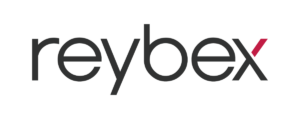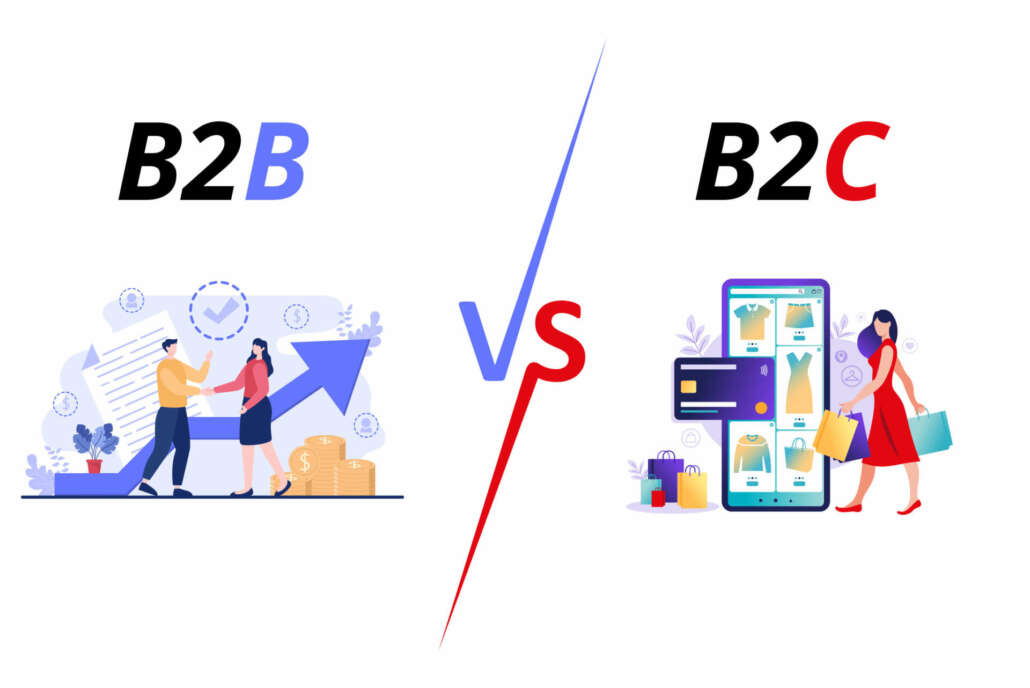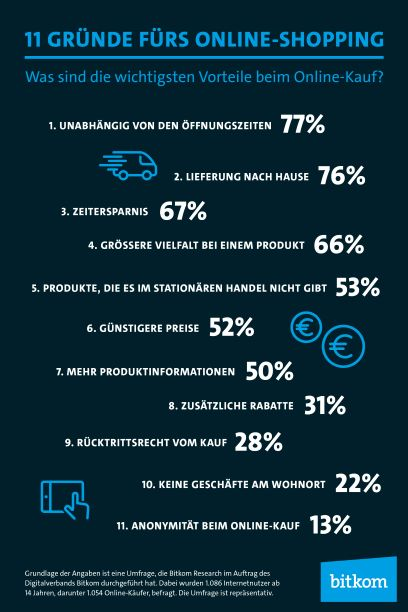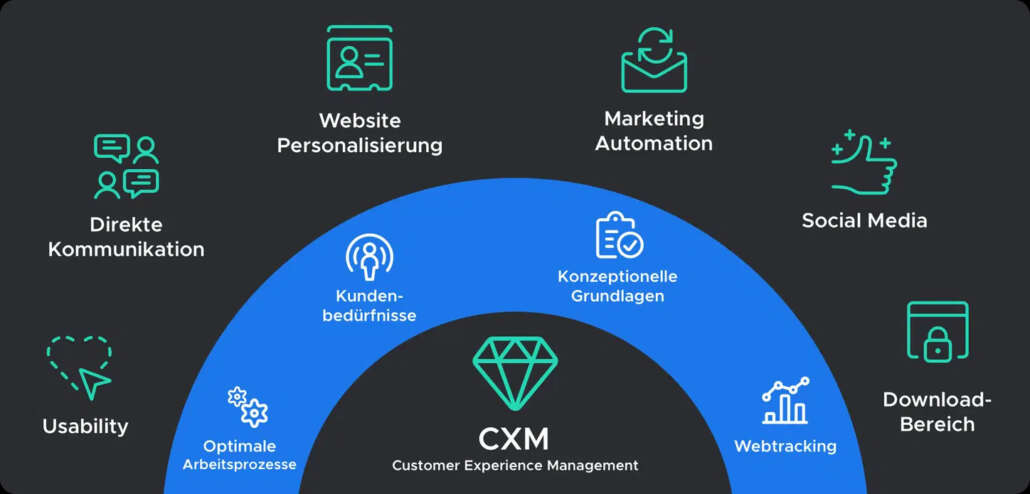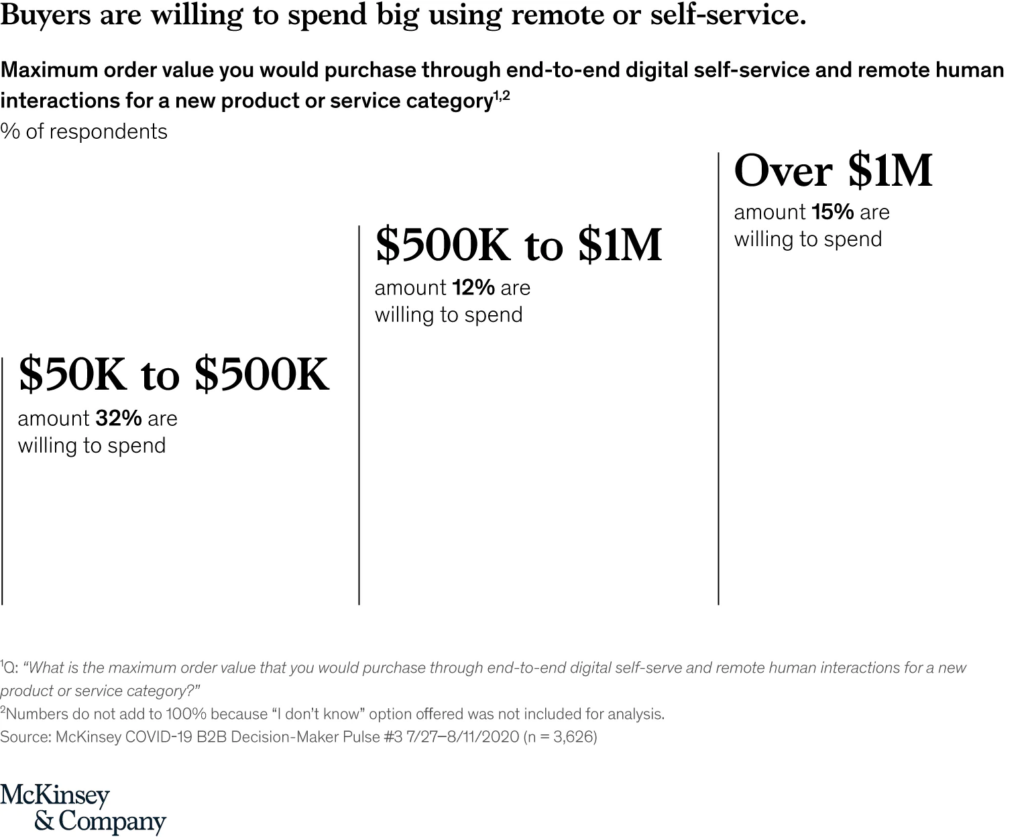B2B vs. B2C E-Commerce
You should know these differences
According to Statista, e-commerce sales in the B2C market totalled around 72.8 billion euros in 2021, of which the top 10 online shops accounted for 27.6 billion euros. After Amazon in first place, Otto is in second place and Zalando in third place among the top-selling e-commerce retailers in Germany. In a survey conducted for the digital association Bitkom e.V., around 77% of 1,050 online users and shoppers cited independence from shop opening hours as a reason for shopping online.
While this survey was limited to private users, i.e. end consumers, figures from the B2B sector show other reasons. Although they are also characterised by a high level of acceptance of digital interaction when shopping, the expectations and wishes of companies that trigger online orders have been changing for years. With the wrong marketing strategies, however, both customers can be quickly scared away in e-commerce.
What does B2B & B2C mean?
Both markets, the B2B and the B2C market, are characterised by psychological purchasing decision processes. For customers, i.e. end consumers, emotional reasons and triggers take centre stage. In the case of companies, i.e. B2B customers, the purchase decision depends largely on prior knowledge and less on emotional involvement. The extent of the research before the B2B purchase is usually more extensive and includes the comparison of several offers.
Companies that order online are more frequently influenced by well-known brands in their decisions, and recent points of contact in particular are becoming a relevant reason for purchase. However, a fast and simple purchasing process is also highly relevant due to the impact of large e-commerce retailers. Customer experience management is driving innovation in the industry and is becoming an existential driver for new strategies.
In the B2B sector, it is much more difficult to influence the purchasing decision process, so the right strategies are all the more important here. It is therefore important to know the differences between the two sales markets.
What are the differences between B2B and B2C e-commerce?
Not only the expectations of products are changing, but also the expectations and wishes of the companies that would buy or purchase from an online shop. Depending on the organisation, the factors to be adapted for the e-commerce sector can be far-reaching. In a McKinsey study from October 2020, companies were asked what expectations they have as B2B buyers.
For 70% of respondents, the desire for digital interactions and self-service offerings is paramount. Even with orders of $50,000 and more. 15% of respondents would also place orders of more than $1 million online if they were convinced by the offer.
Source: McKinsey
Read more information on the topic here: What can you do to sell successfully to business customers in a B2B shop?
From buying centre to selling centre
The digital-first strategy is vital in the B2B sector, as it serves to further develop the offering and ensure that companies can place a new order as easily as possible. Although digital processes are already available in the buying centre, there is a lack of consideration for the individual needs and characteristics of the B2B market.
Therefore, change the mindset in your company and organise the internal structure in your B2B shop in line with a selling centre. Although this sometimes requires a rethink, the new perspective also brings new insights that can be profitably converted into strategies. What is needed is a fundamental rejection of old marketing solutions and a reorientation towards the current needs of B2B customers.
| B2B market in e-commerce | Buying-Center | Selling-Center |
| Interaction between marketing, sales, product, service and IT | ❌ | ✅ |
| Effectively address all the needs of the people involved | ❌ | ✅ |
| Provide relevant digital-first documents | ❌ | ✅ |
| Sales as advisor and supporter | ❌ | ✅ |
| All stakeholders are represented to answer questions before a purchase decision is made | ❌ | ✅ |
| Knowledge database to which all participants have access | ❌ | ✅ |
| Cloud ERP such as the solution from reybex to manage all information centrally | ❌ | ✅ |
| Entire organisation is involved in maintaining customer relationships | ❌ | ✅ |
| Shopping basket abandoners go to sales as leads | ❌ | ✅ |
Personalisation or hyper-personalisation involves providing as many data points as possible that customers can use for orientation when ordering and that are tailored to them. This can only be achieved by an organisational structure that sees itself as a selling centre and acts accordingly. The transformation is supported by artificial intelligence and automation in an innovative ERP system.
What does B2B pricing look like?
Many online retailers are still under the misconception that price determines the market. But there is not just one market price. In fact, the more unique selling points and individual customer benefits the retailer offers, the wider the price range. With an intelligent, selective pricing policy, earnings potential can be increased without losing customers. Price management is often significantly underdeveloped compared to the traditional consumer goods market.
With an integrated approach and continuous commitment, you can develop a professional pricing strategy that is precisely tailored to the B2B market. And even small price increases can have a big impact.
The integrated approach includes the following aspects:
- Variety of offerings with a wide range of additional and other services
- Heterogeneous purchasing decision processes for individual customer needs
- Many decision points to guide the customer
- Consider customer profitability
- Demand behaviour of the market
Pricing for the B2B market is about determining a price point that takes into account the customer benefit in relation to the specific competition. Once the individual, value-determining components of the product have been defined, the individual pricing for the standard products follows. These are supplemented at the end by service fees and optionally upgraded with individual additional services.
Similarities between B2B and B2C e-commerce
In e-commerce, the focus is always on the sale of products or services via digital channels. This applies to both the B2B and B2C markets. However, there are other similarities between these two very different markets. An overview of the most important factors:
| B2B | B2C | |
| Target group | Several decision-makers | Mostly single person only |
| Decision-making power | Often with specialised departments | At the customer’s premises |
| Business relations | Mostly long-term cooperation | Spontaneous purchase |
| Speech | Factual | Emotional |
| Social Media | LinkedIn and Xing | Facebook, Instagram |
| Product | Customised production and adapted to the customer’s wishes | Everyday products without industry-specific expertise |
| Support | Long term | Short term |
| Market share | Niche market | Large market |
| Priority | Lead generation | Brand awareness |
| Content | Technical documentation | Product descriptions |
| Pricing | Customised | In line with the market |
| Previous research | Intensive | Entertaining |
| Volume of transactions | High and very high | Low and medium |
| Marketing through | Trade fair, podcasts, blog, product demos, whitepapers, dialogue with experts | Social media, adverts, Google Ads, TV commercials, radio advertising |
| Customer service | Personal | Standardised |
| Direct sales | Only allowed by post | Only allowed by post |
Why either or? The combination of B2B and B2C e-commerce
Direct sales D2C as a central distribution channel is possible for both the B2B and B2C sectors. This is not the only aspect that shows the possibilities of joint strategies, because as an online retailer you can operate both B2B and B2C. This increases your competitiveness enormously and the quality of the website or online shop and the use of modern software such as reybex’s cloud ERP lay the foundation for both strategies.
It is therefore perfectly possible to make the online shop accessible to B2B and B2C customers if a few changes are made. These include, in particular, the strict separation of B2B and B2C via a separate entry page, as the prices for end customers must include VAT. Different data protection regulations also make strict separation sensible. Separation can also be achieved through different customer profiles and a separate login area.
The reybex B2B shop and the Cloud ERP combine many of these possibilities in one software. The reybex B2B shop and the Cloud ERP combine many of these options in one software.
- Create a password-protected product catalogue for selected customers with negotiated prices
- Use dynamically staggered and discounted prices to respond to high order volumes
- Adjust orders before invoicing
- Automated selling, which increases efficiency
- Enable reordering of past orders in the visible order history
- Make the prices of some articles visible only to wholesale customers or only to end customers
- Define minimum quantities for B2B
- Make certain products available only to a specific customer group
Test the reybex ERP cloud now for 14 days free of charge and without obligation.
